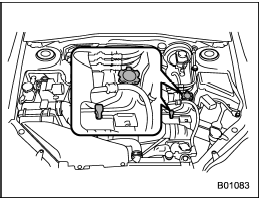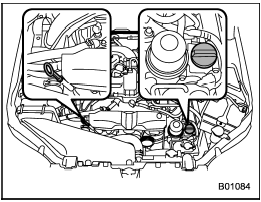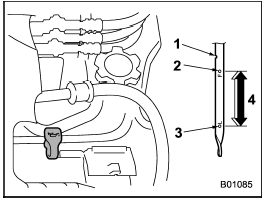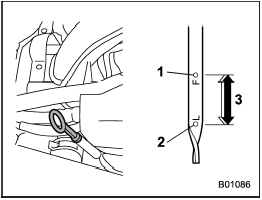Checking the oil level
Check the engine oil level at each fuel stop.
1. Park the vehicle on a level surface and stop the engine.

Turbo models

Non-turbo models
2. Pull out the level gauge, wipe it clean, and insert it again.
3. Be sure the level gauge is correctly inserted until it stops.

Turbo models
1) Notch
2) Upper level
3) Lower level
4) Approximately 1.1 US qt (1.0 liter, 0.9
Imp qt) from lower level to upper level

Non-turbo models
1) Upper level
2) Lower level
3) Approximately 1.1 US qt (1.0 liter, 0.9
Imp qt) from lower level to upper level
4. Pull out the level gauge again and check the oil level on it. If it is below the lower level, add oil to bring the level up to the upper level.

- Use only engine oil with the recommended grade and viscosity.
- Be careful not to spill engine oil when adding it. If oil touches the exhaust pipe, it may cause a bad smell, smoke, and/or a fire. If engine oil gets on the exhaust pipe, be sure to wipe it off.
If you check the oil level just after stopping the engine, wait a few minutes for the oil to drain back into the oil pan before checking the level.
Just after driving or while the engine is warm, the engine oil level reading may be in a range between the upper level and the notch mark. This is caused by thermal expansion of the engine oil.
To prevent overfilling the engine oil, do not add any additional oil above the upper level when the engine is cold.
See also:
Summer tires
The factory-installed tires on your new 2.5 L turbo models are summer tires.
Summer tires are high-speed capability tires best suited for highway driving under
dry conditions.
Summer tires are in ...
Displaying satellite radio ID of tuner
When you activate satellite radio, you should have your satellite radio tuner ID ready because each tuner is identified by its unique satellite radio tuner ID.
The satellite radio ID will be needed w ...
Volume control buttons
Models without Hands-free system
Models with Hands-free system
Press the У+Ф button to increase the
volume. Press the У−Ф button to reduce
the volume.
A number indicating the volume ...


